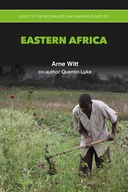Explore

Guide to the Naturalized and Invasive Plants of Eastern Africa
Arne Witt and Quentin Luke
2017
0 Ungluers have
Faved this Work
Login to Fave
Both in Ethiopia and in the countries of East Africa, the continuing proliferation and spread of invasive alien species (IAS) is now recognized as a serious problem, which needs to be addressed. While this situation has improved dramatically over the past 10 years, further progress has been hampered by the absence, hitherto, of a comprehensive IAS database for the region. Countries in the region have repeatedly expressed the need for such a database, as a tool to assist in the identification of naturalized and invasive alien plant species, and in understanding their impacts, both existing and potential, while also providing pointers on what can be done to manage such species. This information is seen as essential, not only in enabling countries to develop effective IAS management strategies, but also in helping them to meet their obligations under various international agreements and treaties, including Article 8 (h) of the Convention on Biological Diversity (CBD) and Target 9 of the 2020 Aichi Biodiversity Targets. In providing such a database, this Guide is intended to give the countries of eastern Africa the information they require, in order to be able to develop effective strategies for combating the growing menace posed by invasive alien plants. It is further hoped that this Guide will foster increased regional collaboration, in responding to the challenges of managing shared invasive plant species. The Guide is based on the findings of extensive roadside surveys, carried out throughout the region, and on a review of the literature pertaining to naturalization and/or invasiveness among alien plants in eastern Africa. By this means, scores of exotic plant species were found to have escaped from cultivation, and to have established populations in the 'wild', to the detriment of natural resources and the millions of people in the region who depend on these resources. Included in the Guide are descriptions of roughly 200 exotic plant species which are either invasive already or which are deemed to have the potential to become invasive in the region. The profiled species include aquatic invasive plants or waterweeds (seven species); vines, creepers or climbers (20 species); terrestrial herbs, shrubs, and succulents (more than 30 species of each), and trees (more than 60 species). Also profiled in this Guide are many exotic plant species which, although their current distribution in the region may still be relatively localized, nevertheless have the potential to become considerably more widespread and problematic. The wide range of habitats and climatic conditions found within Ethiopia and across East Africa make the region as a whole particularly prone to invasions by a host of introduced plant species. Such invasions are being facilitated by increased land degradation, especially through overgrazing and deforestation, and also by climate change.
This book is included in DOAB.
Why read this book? Have your say.
You must be logged in to comment.
Rights Information
Are you the author or publisher of this work? If so, you can claim it as yours by registering as an Unglue.it rights holder.Downloads
This work has been downloaded 106 times via unglue.it ebook links.
- 65 - pdf (CC BY-NC-ND) at Unglue.it.
- 41 - pdf (CC BY-NC-ND) at Unglue.it.
Keywords
- Africa
- Africa South of Sahara
- alien invasive species
- aquatic organisms
- Aquatic plants
- aquatic species
- aquatic weeds
- Biology, Life Sciences
- Botany & plant sciences
- Climate Change
- climatic change
- data banks
- Databases
- East Africa
- Eukaryotes
- exotic organisms
- exotic species
- Geographical Qualifiers
- introduced organisms
- introduced species
- invasive alien species
- invasive organisms
- invasive species
- invasives
- Mathematics & science
- non-indigenous organisms
- Non-Indigenous Species
- non-native organisms
- non-native species
- nonindigenous organisms
- nonindigenous species
- Plants
- sub-Saharan Africa
- subsaharan Africa
- thema EDItEUR::1 Place qualifiers::1H Africa::1HF Sub-Saharan Africa::1HFG East Africa
- thema EDItEUR::P Mathematics and Science::PS Biology, life sciences::PST Botany and plant sciences
- weed control
- Weeds
Links
DOI: 10.1079/9781786392145.0000Editions

